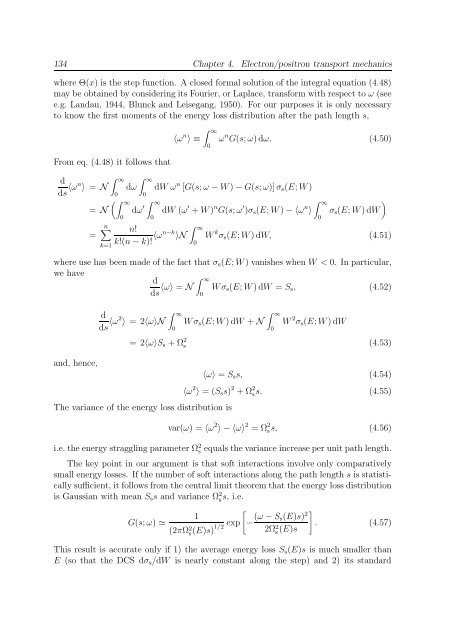PENELOPE 2003 - OECD Nuclear Energy Agency
PENELOPE 2003 - OECD Nuclear Energy Agency
PENELOPE 2003 - OECD Nuclear Energy Agency
Create successful ePaper yourself
Turn your PDF publications into a flip-book with our unique Google optimized e-Paper software.
134 Chapter 4. Electron/positron transport mechanics<br />
where Θ(x) is the step function. A closed formal solution of the integral equation (4.48)<br />
may be obtained by considering its Fourier, or Laplace, transform with respect to ω (see<br />
e.g. Landau, 1944, Blunck and Leisegang, 1950). For our purposes it is only necessary<br />
to know the first moments of the energy loss distribution after the path length s,<br />
From eq. (4.48) it follows that<br />
∫<br />
d<br />
∞<br />
ds 〈ωn 〉 = N dω<br />
0<br />
(∫ ∞<br />
= N<br />
=<br />
n∑<br />
k=1<br />
0<br />
∫ ∞<br />
0<br />
dω ′ ∫ ∞<br />
0<br />
〈ω n 〉 ≡<br />
n!<br />
k!(n − k)! 〈ωn−k 〉N<br />
∫ ∞<br />
0<br />
ω n G(s; ω) dω. (4.50)<br />
dW ω n [G(s; ω − W ) − G(s; ω)] σ s (E; W )<br />
∫ ∞<br />
dW (ω ′ + W ) n G(s; ω ′ )σ s (E; W ) − 〈ω n 〉<br />
∫ ∞<br />
0<br />
0<br />
)<br />
σ s (E; W ) dW<br />
W k σ s (E; W ) dW, (4.51)<br />
where use has been made of the fact that σ s (E; W ) vanishes when W < 0. In particular,<br />
we have<br />
∫<br />
d<br />
∞<br />
ds 〈ω〉 = N W σ s (E; W ) dW = S s , (4.52)<br />
0<br />
and, hence,<br />
∫<br />
d<br />
∞<br />
∫ ∞<br />
ds 〈ω2 〉 = 2〈ω〉N W σ s (E; W ) dW + N W 2 σ s (E; W ) dW<br />
0<br />
0<br />
= 2〈ω〉S s + Ω 2 s (4.53)<br />
The variance of the energy loss distribution is<br />
〈ω〉 = S s s, (4.54)<br />
〈ω 2 〉 = (S s s) 2 + Ω 2 ss. (4.55)<br />
var(ω) = 〈ω 2 〉 − 〈ω〉 2 = Ω 2 ss, (4.56)<br />
i.e. the energy straggling parameter Ω 2 s equals the variance increase per unit path length.<br />
The key point in our argument is that soft interactions involve only comparatively<br />
small energy losses. If the number of soft interactions along the path length s is statistically<br />
sufficient, it follows from the central limit theorem that the energy loss distribution<br />
is Gaussian with mean S s s and variance Ω 2 ss, i.e.<br />
[<br />
1<br />
G(s; ω) ≃<br />
(2πΩ 2 s(E)s) exp − (ω − S s(E)s) 2 ]<br />
1/2 2Ω 2 s (E)s . (4.57)<br />
This result is accurate only if 1) the average energy loss S s (E)s is much smaller than<br />
E (so that the DCS dσ s /dW is nearly constant along the step) and 2) its standard
















